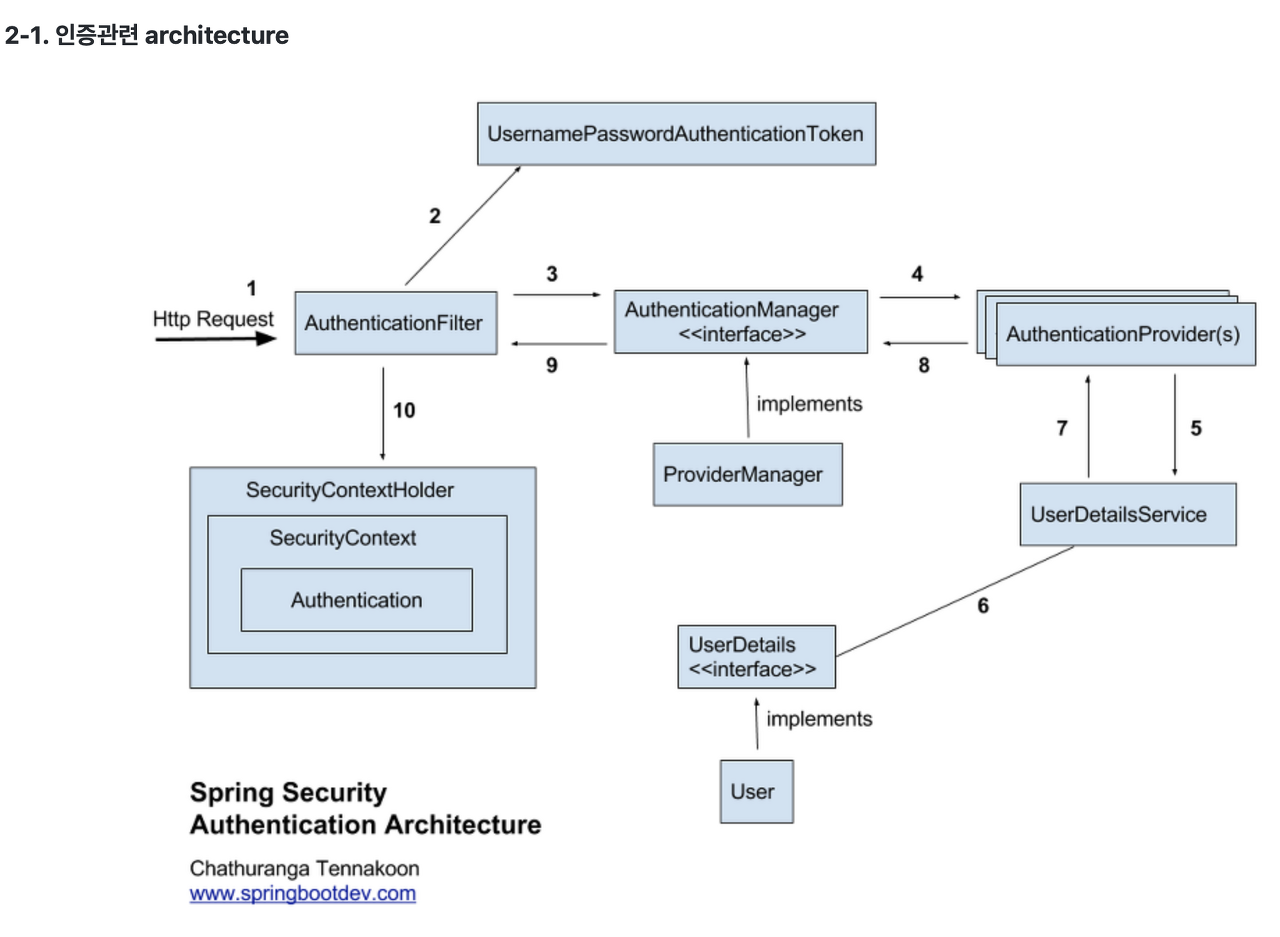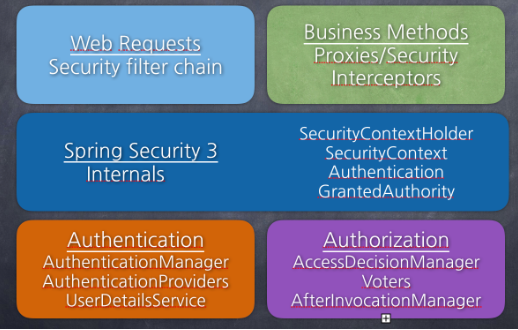Spring Security
by jsh
Spring Security
- Spring Security
SpringSecurity
Spring Security는 Spring 기반의 Application의 보안(인증과 권한,인가 등)을 담당하는 Spring 하위 Framewrork이다.
Spring Security는 ‘인증’과 ‘권한’에 대한 부분을 Filter 흐름에 따라 처리하고 있다.
Filter는 Dispatcher Servlet으로 가기 전에 적용되므로 가장 먼저 URL 요청을 받지만 Interceptor는 Dispatcher와 Contoller사이에 위치한다는 점에서 적용 시기의 차이가 있다.
Spring Security는 보안과 관련해서 체계적으로 많은 옵션을 제공해주기 때문에 개발자 입장에서는 일일이 보안 관련 로직을 작성하지 않아도 된다는 장점이 있다.
이러한 Spring Security의 아키텍처는 아래와 같다.

Module

-
SecurityContextHolder: 보안 주체의 세부 정보를 포함하여 응용프로그램의 현재 보안 Context에 대한 세부 정보가 저장 된다. 기본적으로 SecurityContextHolder.MODE_INHERITABLETHREADLOCAL 방법과 SecurityContextHolder.MODE_THREADLOCAL 방법을 제공한다.
-
SecurityContext: Authentication을 보관하는 역할을 하며 SecurityContext를 통해 Authentication 객체를 꺼내 올 수 있다.
-
Authentication: 현재 접근하는 주체의 정보와 권한을 담는 인터페이스이다. Authentication 객체는 Security Context에 저장되며, SecurityContextHolder를 통해 SecurityConext에 접근하고 SecurityContext를 통해 Authentication에 접근 할 수 있다.
-
UsernamePasswordAuthenticationToken: Authentication을 implements한 AbstractAuthenticationToken의 하위 클래스로 User의 ID가 Principal 역할을 하고 Password가 Credential의 역할을 한다.
-
AuthenticationProvider: 실제 인증에 대한 부분을 처리하는데, 인증 전의 Authentication객체를 받아서 인증이 완료된 객체를 반환하는 역할을 한다.
-
AuthenticationManager: AuthenticationManager에 등록된 AuthenticationProvider에 의해 처리된다. 인증이 성공하면 2번째 생성자를 이용해 인증이 성공한(isAuthenticated=true) 객체를 생성하여 Security Context에 저장한다. 인증 상태를 유지하기 위해 세션에 보관하며, 인증이 실패한 경우에는 AuthenticationException를 발생시킨다.
-
UserDetails: 인증에 성공하여 생성된 UserDetails 객체는 Authentication객체를 구현한 UsernamePasswordAuthenticationToken을 생성하기 위해 사용된다.
-
UserDetailsService: UserDetailsService 인터페이스는 UserDetails 객체를 반환하는 단 하나의 메소드를 가지고 있는데, 일반적으로 이를 구현한 클래스의 내부에 UserRepository를 주입받아 DB와 연결하여 처리한다.
-
PasswordEncoding: AuthenticationManagerBuilder.userDetailsService().passwordEncoder() 를 통해 패스워드 암호화에 사용될 PasswordEncoder 구현체를 지정할 수 있다.
-
GrantedAuthority: GrantAuthority는 현재 사용자(principal)가 가지고 있는 권한을 의미한다. ROLE_ADMIN나 ROLE_USER와 같이 ROLE_*의 형태로 사용하며, 보통 “roles” 이라고 한다. GrantedAuthority 객체는 UserDetailsService에 의해 불러올 수 있고, 특정 자원에 대한 권한이 있는지를 검사하여 접근 허용 여부를 결정한다.
Dependency
<dependency>
<groupId>org.springframework.boot</groupId>
<artifactId>spring-boot-starter-web</artifactId>
</dependency>
<dependency>
<groupId>org.springframework.boot</groupId>
<artifactId>spring-boot-starter-security</artifactId>
</dependency>
<dependency>
<groupId>org.springframework.boot</groupId>
<artifactId>spring-boot-starter-thymeleaf</artifactId>
</dependency>
<dependency>
<groupId>org.springframework.boot</groupId>
<artifactId>spring-boot-starter-data-jpa</artifactId>
</dependency>
<dependency>
<groupId>org.thymeleaf.extras</groupId>
<artifactId>thymeleaf-extras-springsecurity5</artifactId>
</dependency>
<dependency>
<groupId>org.projectlombok</groupId>
<artifactId>lombok</artifactId>
<version>1.18.20</version>
<scope>provided</scope>
</dependency>
<dependency>
<groupId>org.mariadb.jdbc</groupId>
<artifactId>mariadb-java-client</artifactId>
</dependency>
<dependency>
<groupId>org.springframework.boot</groupId>
<artifactId>spring-boot-starter-test</artifactId>
<scope>test</scope>
</dependency>
<dependency>
<groupId>org.springframework.security</groupId>
<artifactId>spring-security-test</artifactId>
<scope>test</scope>
</dependency>
Gradle
implementation 'org.springframework.boot:spring-boot-starter-data-jpa'
implementation 'org.springframework.boot:spring-boot-starter-security'
implementation 'org.springframework.boot:spring-boot-starter-thymeleaf'
implementation 'org.springframework.boot:spring-boot-starter-web'
implementation 'org.thymeleaf.extras:thymeleaf-extras-springsecurity5'
compileOnly 'org.projectlombok:lombok'
runtimeOnly 'org.mariadb.jdbc:mariadb-java-client'
annotationProcessor 'org.projectlombok:lombok'
testImplementation 'org.springframework.boot:spring-boot-starter-test'
testImplementation 'org.springframework.security:spring-security-test'
WebSecurity생성
package com.jsh.security.example.config;
import com.jsh.security.example.filter.CustomAuthenticationFilter;
import com.jsh.security.example.handler.CustomLoginSuccessHanlder;
import com.jsh.security.example.provider.CustomAuthenticationProvider;
import lombok.extern.slf4j.Slf4j;
import org.springframework.boot.autoconfigure.security.servlet.PathRequest;
import org.springframework.context.annotation.Bean;
import org.springframework.context.annotation.Configuration;
import org.springframework.security.config.annotation.authentication.builders.AuthenticationManagerBuilder;
import org.springframework.security.config.annotation.web.builders.HttpSecurity;
import org.springframework.security.config.annotation.web.builders.WebSecurity;
import org.springframework.security.config.annotation.web.configuration.EnableWebSecurity;
import org.springframework.security.config.annotation.web.configuration.WebSecurityConfigurerAdapter;
import org.springframework.security.crypto.bcrypt.BCryptPasswordEncoder;
import org.springframework.security.web.authentication.UsernamePasswordAuthenticationFilter;
@Slf4j
@Configuration
@EnableWebSecurity
public class WebSecurityConfig extends WebSecurityConfigurerAdapter {
@Override
public void configure(WebSecurity web) throws Exception {
web.ignoring().requestMatchers(PathRequest.toStaticResources().atCommonLocations());
}
@Override
protected void configure(HttpSecurity http) throws Exception {
log.info("3. Login Authorization 설정");
http.csrf().disable().authorizeRequests()
.antMatchers("/about").authenticated()
.antMatchers("/admin").hasRole("ADMIN")
.anyRequest().permitAll()
.and()
.formLogin()
.loginPage("/user/loginView")
.successForwardUrl("/inedx")
.failureForwardUrl("/index")
.permitAll()
.and()
.addFilterBefore(customAuthenticationFilter(), UsernamePasswordAuthenticationFilter.class); //login실행 전 login parameter에 대한 filter실행
}
@Bean
public BCryptPasswordEncoder bCryptPasswordEncoder(){
return new BCryptPasswordEncoder();
}
@Bean
public CustomAuthenticationFilter customAuthenticationFilter() throws Exception {
CustomAuthenticationFilter customAuthenticationFilter = new CustomAuthenticationFilter(authenticationManager());
customAuthenticationFilter.setFilterProcessesUrl("/user/login");
customAuthenticationFilter.setAuthenticationSuccessHandler(customLoginSuccessHandler());
customAuthenticationFilter.afterPropertiesSet();
return customAuthenticationFilter;
}
@Bean
public CustomLoginSuccessHanlder customLoginSuccessHandler() {
return new CustomLoginSuccessHanlder();
}
@Bean
public CustomAuthenticationProvider customAuthenticationProvider(){
return new CustomAuthenticationProvider(bCryptPasswordEncoder());
}
@Override
protected void configure(AuthenticationManagerBuilder auth) throws Exception {
auth.authenticationProvider(customAuthenticationProvider());
}
}
AuthenticateFilter생성
package com.jsh.security.example.filter;
import lombok.extern.slf4j.Slf4j;
import org.springframework.security.authentication.AuthenticationManager;
import org.springframework.security.authentication.UsernamePasswordAuthenticationToken;
import org.springframework.security.core.Authentication;
import org.springframework.security.core.AuthenticationException;
import org.springframework.security.web.authentication.UsernamePasswordAuthenticationFilter;
import javax.servlet.http.HttpServletRequest;
import javax.servlet.http.HttpServletResponse;
@Slf4j
public class CustomAuthenticationFilter extends UsernamePasswordAuthenticationFilter {
public CustomAuthenticationFilter(AuthenticationManager authenticationManager) {
super.setAuthenticationManager(authenticationManager);
}
@Override
public Authentication attemptAuthentication(HttpServletRequest request, HttpServletResponse response) throws AuthenticationException {
UsernamePasswordAuthenticationToken authenticationToken = new UsernamePasswordAuthenticationToken(
request.getParameter("userEmail")
,request.getParameter("userPw")
);
setDetails(request, authenticationToken);
return this.getAuthenticationManager().authenticate(authenticationToken);
}
}
AuthenticationProvider생성
package com.jsh.security.example.provider;
import com.jsh.security.example.vo.UserDetailsVO;
import lombok.NonNull;
import lombok.RequiredArgsConstructor;
import lombok.extern.slf4j.Slf4j;
import org.springframework.security.authentication.AuthenticationProvider;
import org.springframework.security.authentication.BadCredentialsException;
import org.springframework.security.authentication.UsernamePasswordAuthenticationToken;
import org.springframework.security.core.Authentication;
import org.springframework.security.core.AuthenticationException;
import org.springframework.security.core.userdetails.UserDetailsService;
import org.springframework.security.crypto.bcrypt.BCryptPasswordEncoder;
import javax.annotation.Resource;
@RequiredArgsConstructor
@Slf4j
public class CustomAuthenticationProvider implements AuthenticationProvider {
@Resource(name = "userDetailsService")
private UserDetailsService userDetailsService;
@NonNull
private final BCryptPasswordEncoder passwordEncoder;
@Override
public Authentication authenticate(Authentication authentication) throws AuthenticationException {
UsernamePasswordAuthenticationToken token = (UsernamePasswordAuthenticationToken) authentication;
String userEmail = token.getName();
String userPw = (String) token.getCredentials();
UserDetailsVO userDetailsVO = (UserDetailsVO) userDetailsService.loadUserByUsername(userEmail);
if (!passwordEncoder.matches(userPw, userDetailsVO.getPassword())){
throw new BadCredentialsException(userDetailsVO.getUsername() + "Invalid password");
}
return new UsernamePasswordAuthenticationToken(userDetailsVO, userPw, userDetailsVO.getAuthorities());
}
@Override
public boolean supports(Class<?> authentication) {
return authentication.equals(UsernamePasswordAuthenticationToken.class);
}
}
UserDetailsService생성
package com.jsh.security.example.service;
import com.jsh.security.example.exception.UserNotFoundException;
import com.jsh.security.example.repository.UserRepository;
import com.jsh.security.example.vo.UserDetailsVO;
import lombok.AllArgsConstructor;
import lombok.extern.slf4j.Slf4j;
import org.springframework.security.core.authority.SimpleGrantedAuthority;
import org.springframework.security.core.userdetails.UserDetails;
import org.springframework.security.core.userdetails.UserDetailsService;
import org.springframework.security.core.userdetails.UsernameNotFoundException;
import org.springframework.stereotype.Service;
import java.util.Collections;
@Slf4j
@AllArgsConstructor
@Service("userDetailsService")
public class UserDetailsServiceImpl implements UserDetailsService {
private final UserRepository userRepository;
@Override
public UserDetails loadUserByUsername(String userEmail) throws UsernameNotFoundException {
return userRepository.findByUserEmail(userEmail)
.map(u -> new UserDetailsVO(u, Collections.singleton(new SimpleGrantedAuthority(u.getRole().getValue()))))
.orElseThrow(() -> new UserNotFoundException(userEmail))
;
}
}
UserRepository생성
package com.jsh.security.example.repository;
import com.jsh.security.example.vo.UserVO;
import org.springframework.data.jpa.repository.JpaRepository;
import org.springframework.stereotype.Repository;
import java.util.Optional;
@Repository
public interface UserRepository extends JpaRepository <UserVO, Long> {
UserVO findByUserEmailAndUserPw(String userId, String userPw);
Optional<UserVO> findByUserEmail(String userEmail);
}
UserEntity생성
package com.jsh.security.example.vo;
import com.jsh.security.example.enums.role.UserRole;
import com.jsh.security.example.vo.common.CommonVO;
import lombok.Builder;
import lombok.Getter;
import lombok.NoArgsConstructor;
import lombok.Setter;
import javax.persistence.*;
import java.io.Serializable;
@NoArgsConstructor
@Entity
@Table(name = "USER")
@Getter
public class UserVO extends CommonVO implements Serializable {
@Setter
@Column(nullable = false, unique = true, length = 50)
private String userEmail;
@Setter
@Column(nullable = false)
private String userPw;
@Setter
@Column(nullable = false, length = 50)
@Enumerated(EnumType.STRING)
private UserRole role;
@Builder
public UserVO(String userEmail, String userPw) {
this.userEmail = userEmail;
this.userPw = userPw;
}
}
UserDetails생성
package com.jsh.security.example.vo;
import lombok.Getter;
import lombok.RequiredArgsConstructor;
import lombok.experimental.Delegate;
import org.springframework.security.core.GrantedAuthority;
import org.springframework.security.core.userdetails.UserDetails;
import java.util.Collection;
@RequiredArgsConstructor
@Getter
public class UserDetailsVO implements UserDetails {
@Delegate
private final UserVO userVO;
private final Collection<? extends GrantedAuthority> authorities;
@Override
public Collection<? extends GrantedAuthority> getAuthorities() {
return authorities;
}
@Override
public String getPassword() {
return userVO.getUserPw();
}
@Override
public String getUsername() {
return userVO.getUserEmail();
}
@Override
public boolean isAccountNonExpired() {
return userVO.getIsEnable();
}
@Override
public boolean isAccountNonLocked() {
return userVO.getIsEnable();
}
@Override
public boolean isCredentialsNonExpired() {
return userVO.getIsEnable();
}
@Override
public boolean isEnabled() {
return userVO.getIsEnable();
}
}
Subscribe via RSS
